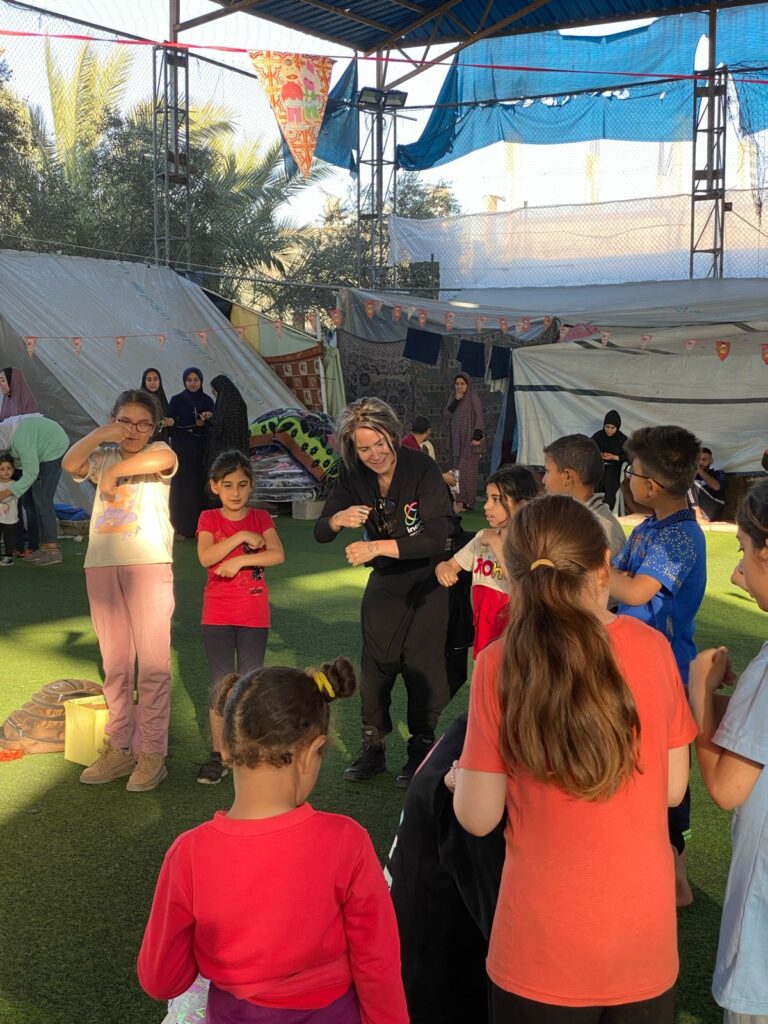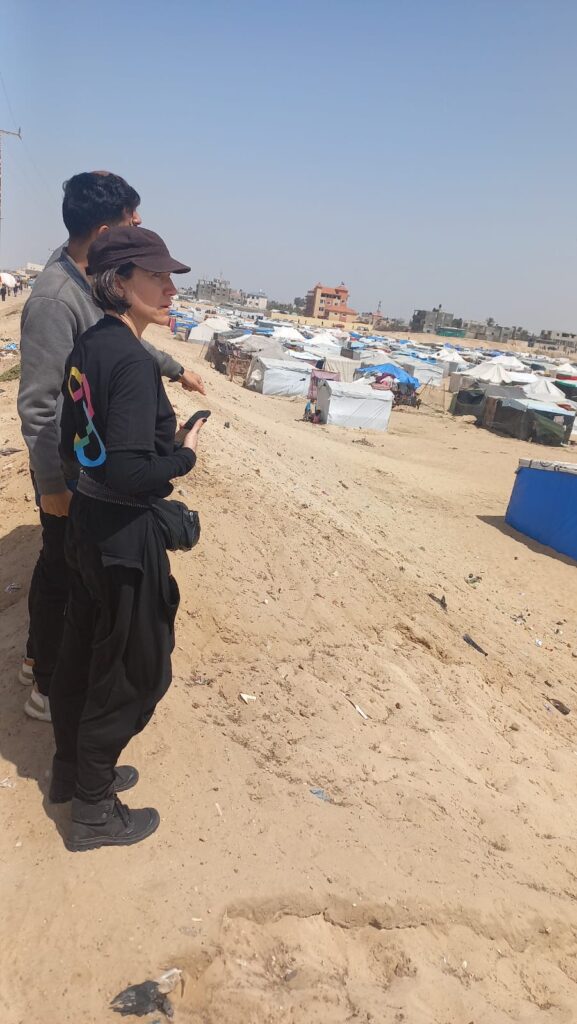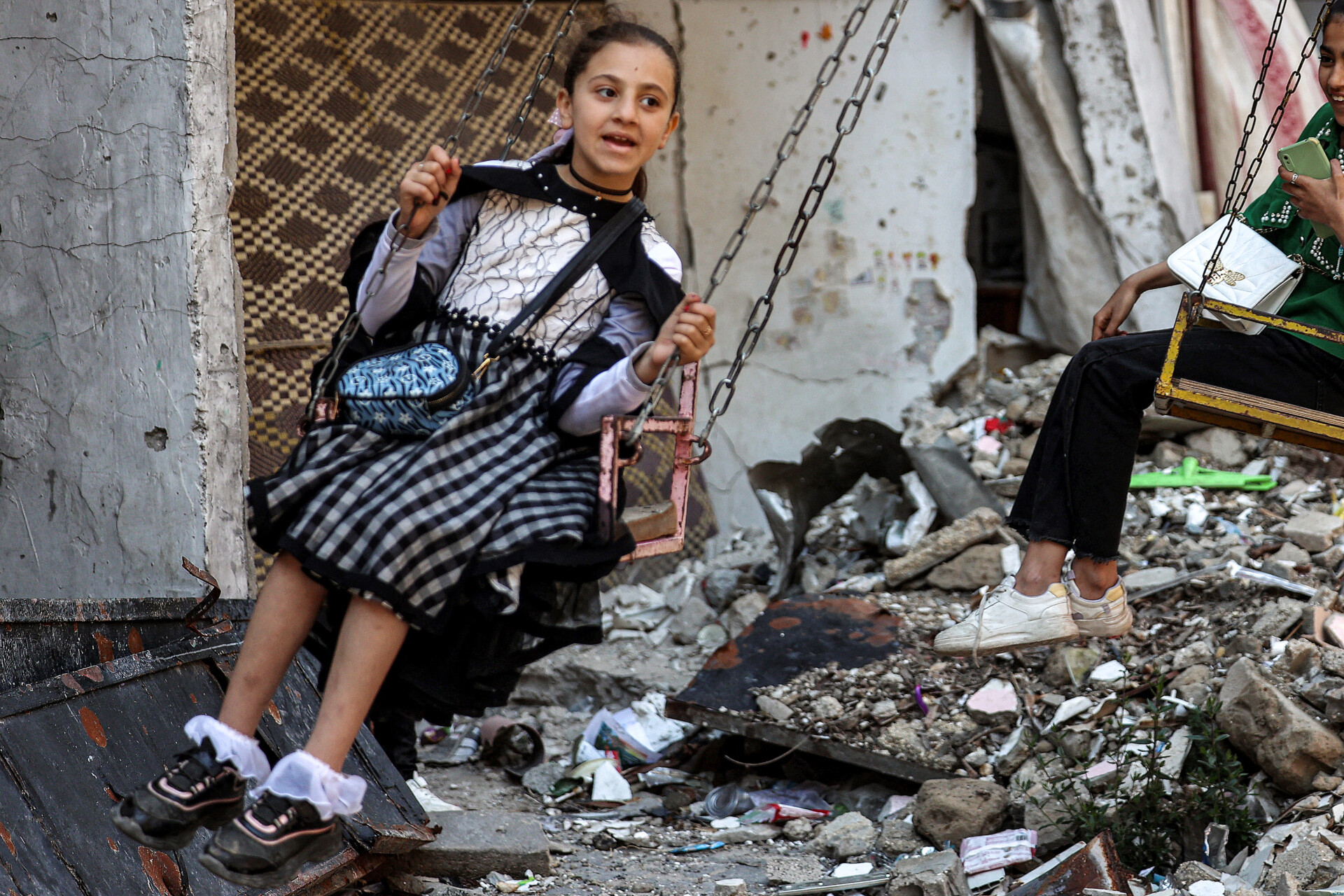We weave out of the traffic jam of human misery that is Rafah, in southern Gaza, and onto a wide, empty street.
“Why is there no one here?” I ask Mohamad al-Zebdeh and his cousin Adel, who is driving us.
“Oh, this road can be dangerous,” al-Zebdeh responds. “Look, see that blown-up car? The Israelis hit it. They said it was carrying a Hamas guy.”
We drive past the burned-out hulk of that vehicle, and I shrink smaller into my seat, as if that’s somehow going to protect me. It’s a few days after the strike on the World Central Kitchen convoy. I’m used to being in war zones; I’m used to an element of unpredictability. But I haven’t been able to shake the jitters since I got into Gaza a few days earlier.
A young boy in scuffed-pink rollerblades comes racing down one of the hospital garden’s walkways, dodging the displaced. He speeds by me calling out, “Hello, what’s your name?”
“Arwa,” I respond, invariably smiling at the unexpected sweetness of this brief moment that distracts from the stench of sewage running along the tents all over the hospital grounds and my knotted, impossible-to-detangle thoughts.
“This is all a source of infection. There are more displaced [people] camped out everywhere than there are patients and medical staff,” al-Zebdeh says. There have been similar scenes at all of Gaza’s hospitals, the vast majority of which have been decimated. This, the European Hospital, is one of the few still semi-functioning facilities.
It is six months into Israel’s war in Gaza, a war that has decimated the medical infrastructure, left Gaza’s population of some 2.2 million without proper access to power, water, food or medicine, pulverized people’s homes and livelihoods, and displaced more than 1.5 million into the southern part of the Gaza Strip. It is also a war that has killed more people, including more children, in such a short amount of time than any other war zone that I have been in in the past 20 years.
I am here on a humanitarian mission with my charity, INARA, which I established in 2015 when I was still a senior correspondent with CNN. Our main focus is in ensuring long-term medical and mental health care for children injured due to war and natural disasters. In Gaza, in this horrid “emergency,” we have been working with shelters providing an array of services from hot meals to rewashable sanitary underwear to activities for children. We’re also in the process of setting up medical points.
Al-Zebdeh is taking me to see some of the injured children he’s working to get out. The organization he helped co-found, Children Not Numbers, is helping the injured with their paperwork and applications to transfer out of Gaza. INARA, in addition to our work inside Gaza, is also supporting injured children and their families with medical, mental health and general needs once they have transferred out.

The entire process is far from straightforward. The list of those requesting evacuation is long, arduous and fraught with challenges.
We enter one of the hospital buildings, threading our way through the makeshift shelters that line the corridors, the families camped out on stairwells. It’s swelteringly hot, and just about impossible to walk through without tripping over something or someone. Women cook on the floor, children dart around, babies cry, the wounded moan in their beds.
Technically speaking, al-Zebdeh is not yet a doctor. He’s in his final year, studying plastic and reconstructive surgery, but everyone already calls him doctor. Like many of Gaza’s higher education students, especially those in the medical field, he wants to get out, finish his degree and come back as a professional to help his people. It’s an aspect of this war that is not often discussed, how education was just frozen.
“I saw a boy die from pain,” he had told me earlier. “He was 10 years old, and they were amputating, cutting through his leg with no anesthesia. He just died. That was in Nasir hospital. He was actually the son of another doctor.”
We follow a screaming toddler with a bandaged head coddled by his mother down into one ward. Al-Zebdeh pulls back a blanket that is acting as a separation and introduces me to Adham. I try not to stare. His skull has a massive indentation, larger than my fist. He miraculously has all of his cognitive functions but is unable to move his left side. His father tells us he was supposed to be transferred, but he and his mother were turned back at the border because she doesn’t have a passport.
There are no “rooms” here, just bed after bed cordoned off from each other by blankets. I catch glimpses of love that warm my heart — a sister kissing her younger sibling who has a bandaged leg, a father planting a kiss on his son’s forehead. My mind rearranges what it’s seeing into the life that was. I can imagine these families in their homes — the children darting off to school, laughter around meals.
I see traces of their little cheeky personalities. Those who wave shyly to me, the foreigner. Those who chase us, shrieking down corridors before al-Zebdeh is able to gently shoo them off.
“This is a 10-year-old child, gunshot wound to the head,” the head nurse of the intensive care unit says, pointing to Mustafa’s chart.
“Gunshot?”
“Yes, in and out.”
Mustafa’s chest heaves with each labored breath the machines force through his unresponsive body.
“He was shot in Mawasi, when he was out with his uncle,” Mustafa’s father says. “I don’t understand. We fled twice; we did what they said. It doesn’t make sense. Mawasi was supposed to be safe.”
He shows me pictures of Mustafa’s plants. He loved to garden. He was the top of his class.
“I swear if he doesn’t make it, it will kill the whole family.”

I walk past beds of children in bandages, children with metal rods poking out of tiny legs and arms, children with burns, children with necrotic tissue. Like many others, I watched Gaza’s horror unfold on TV and social media and lacked the words to express it. I am here; I am seeing it for myself. I understand so much more, and yet I find myself even more incapable of articulating the extent of what I am witnessing.
Rafif waves from her bed, and I am instantly captivated. I take in her protruding cheekbones, the metal bars holding her leg together, her amputated foot, but all I can see is her smile. It feels almost unnaturally bright in a place like this.
“I am 15, and that’s my brother. He’s 16,” she says. “Rafik, say ‘cheese!’”
Rafik barely groans back. I can see every bone in his spine, every rib. He’s severely malnourished, just skin and bone, hooked up to an IV.
The siblings were in a hospital in the north and managed to get evacuated to the south about a week ago.
“The strike happened on Jan. 29,” Rafif says, her smile barely wavering. “It was 6 a.m. They hit the upper floor. Eleven people died. And I am like this.”
The power cut in the middle of her story, and in the darkness she blurts out: “I like your outfit. You have a cool look.”
I’m so taken back by this normal teenage comment that I burst out laughing. I want to promise her that one day I will take her shopping, but I’m afraid to even articulate that desire, lest it be a promise I am unable to keep.
The heart shatters into a million pieces, the brain snaps trying to find solutions even if for the smallest of things. The unknown looms over everything, its soundtrack the constant buzz of drones, explosions, cries of children, pleas for help.
That night, back at the house I’m crashing in, I’m sitting in the dark, trying to save battery power. I can hear the Quran being recited in a broadcast from the house next door, wafting through the windows that shake and tremble with each strike. I am in the dark, and in that darkness all I see is the faces of Gaza’s children, their pain, their wretched present and their stolen futures.
“Spotlight” is a newsletter about underreported cultural trends and news from around the world, emailed to subscribers twice a week. Sign up here.



